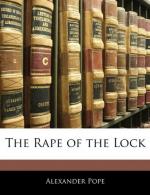|
This section contains 8,168 words (approx. 28 pages at 300 words per page) |

|
SOURCE: “Imperialism and Poetic Form: The Rape of the Lock (1712, 1714, 1717), Windsor-Forest (1713),” in Alexander Pope, Basil Blackwell, 1985, pp. 6-45.
In the following excerpt, Brown explores tensions and contradictions between the mercantile discourse and neoclassical aesthetics of The Rape of the Lock, highlighting the dependence of Pope's poetic diction upon the commodification of English culture.
The most familiar couplet in all of Pope's corpus—and perhaps in all of Augustan poetry—is the definition of art in An Essay on Criticism (1711):
True Wit is Nature to Advantage drest, What oft was Thought, but ne’er so well Exprest.(1)
(297-8)
These lines have been taken as the central statement of neo-classical aesthetics, and for that reason they have been subtly read and reread by modern critics seeking to define precisely the delicate interaction between art and nature that Pope's metaphor implies. Reuben Brower, in a sustained analysis of Pope's use of...
|
This section contains 8,168 words (approx. 28 pages at 300 words per page) |

|


